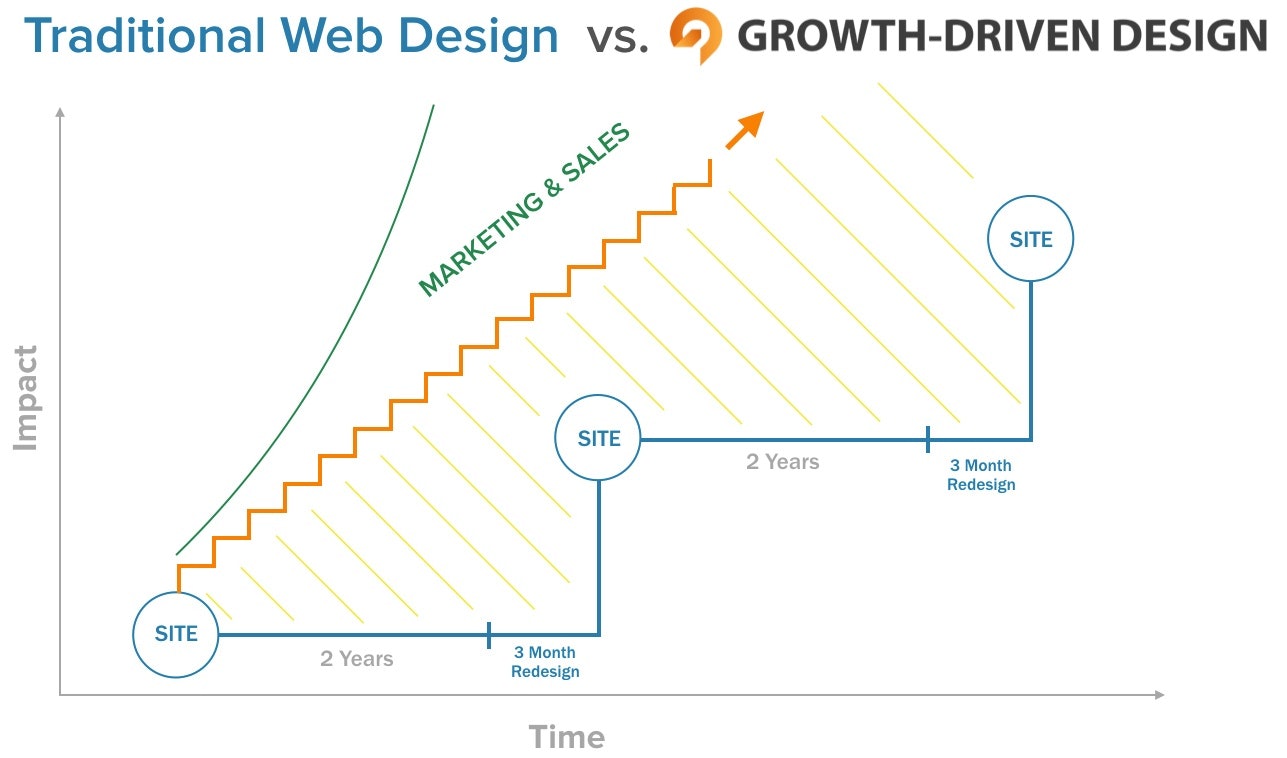There’s no debate: even in industries where people prefer more traditional marketing and advertising channels, you must have a website where information is readily available, on par with modern standards of usability.
What the modern marketing organization has to determine, however, is how you are going to continue to invest in and optimize your website.
From the moment it became clear that every business was going to need a digital presence, we’ve known that websites were never again going to be one-time investments. The difference between 2007 and 2017 is that it’s now clear that websites require constant investment, not redesigns every 2-5 years.
Continuous Improvement: The Modern Standard for Web Design
If you’ve already adopted a continuous improvement philosophy within your own web design process, then skip down to the next section.
There was a time when it was sufficient to slap a new website up every few years without really having to edit the infrastructure of your site in the interim. Post a new blog once a month, add that shiny new Twitter account you just signed up for, and you were golden.
Then users started to demand more. The most innovative brands and publications demonstrated that the Internet could not only be enjoyable, but also beautiful and easy to use (with ever-increasing expectations for how enjoyment, aesthetics, and usability were defined). And where user expectations go, browsers and search engines follow.
Browsers
With tech giants like Google and Apple contributing to and borrowing from design trends every year, it’s no longer an option to let a website look the same for years on end. If a user visits your 2014 website using a 2017 browser, at best there will be discrepancies. At worst, your website will give lost customers a laugh before they run to the hills flanking the Information Superhighway and never return.
The capabilities of browsers and websites are only going to grow. Yesterday’s software and desktop apps are now built as fully functioning web technologies – for examples, see Basecamp and Slack. And while you might be saying to yourself, “But Zack, we’re not a software company,” that might be true – but you’re still competing with the expectations these companies are setting.
Keeping up with these developments is only going to get more challenging if you’re not prepared to continuously invest in your website.
Search Engines
Google (and their remaining competitors) has also changed the way content is valued on the web, again, in the interest of serving the needs of users. Responsive (read: mobile-first), fast-loading websites and content that is both well-designed and frequently updated appear higher in search – you can’t keyword stuff or meta description your way to page 1 (and yet, it’s absolutely still critical that you get your keywords and meta descriptions in order).
On the opposite end of that spectrum, Flash-based websites may as well be extinct in 2017 (although that’s not to say they’re of absolutely no value – go have a laugh).
In short, today the pace of iteration, innovation, and change is simply way too fast for complete redesigns to be viable options for brands trying to keep up with their buyers and stakeholders. Which means that you have to adopt a new paradigm, one in which you’re always testing, measuring, and optimizing your website to meet the expectations of your buyers and the needs of your business.
Luke Summerfield from HubSpot developed a framework that compares the old model of web design and development to the new model, which he has coined Growth-driven Design. While we use the phrase Continuous Improvement, the idea is the same.
There are a million strategies housed under this umbrella – conversion rate optimization, failure mapping, heatmapping, user testing, SEO, lead nurturing, link-building, content marketing, website security, etc., etc., etc. The only way to know which particular tactics you need to adopt is to first understand your business objectives and your buyers’ needs.
Are Website Redesigns Dead?
Of course not. We know firsthand that sometimes that the best way to update your digital infrastructure is to build it from the ground up. To use the metaphor of homebuilding, often all you need is minor renovation or a new addition, but there are times when you inspect your foundation and realize the whole house may soon collapse. When that happens, it’s time to move.
But it’s important that you evaluate all of your options before you decide to redesign your website. Are there ways to update individual sections of your site so that you use the analytics and user behavior data you’ve already collected to inform your decision-making? Because a new website build almost always entails more assumptions about what is best for your users than does optimizing your existing website.
If you do redesign your website, it’s important you build for scale and prepare for a long road of improvement ahead when you do. Your website launch is not the finish line.
What It Takes
As you can probably tell by now, this ain’t easy. While the idea of continuous improvement is certainly better suited to providing measurable and considerable ROI than the infrequent redesign, you have to budget appropriately for the reality these small improvements will be never-ending.
And more importantly, you need to have the right talent in place to oversee this website optimization. Perhaps it’s your in-house marketing department. Perhaps it’s a marketing agency, funded by a digital marketing retainer. Often it’s a combination of the two. But whatever the case may be, it’s important that all of your stakeholders are always aligned – your VP, marketing manager, content team, UX expert, social media specialists, developers, and designers all need to have a clear set of goals, insight into performance, and an explicit understanding of who is responsible for what. Otherwise, you’re going to be disappointed with how you’re spending your money.
And remember, while there is definitely a cost associated with continuously improving your website, you can’t afford to fall behind. Improve continuously, and you’ll never be outdated or stale again. Your website is critical. Make sure it stays current.






